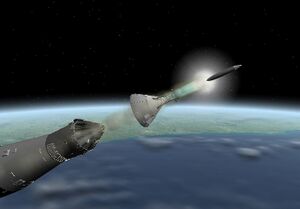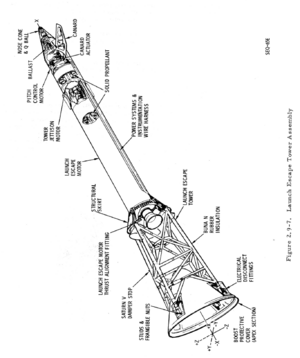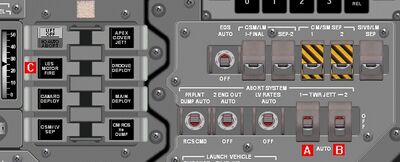Launch Escape System

The Launch Escape System (LES) consists of the Boost Protective Cover (BPC) over the Command Module (CM), the attached Launch Escape Tower (LET) and associated electronics and pyrotechnics.
Launch Escape Tower

The LET contains three solid rocket motors.
The Launch Escape Motor is the largest, positioned at the bottom of the tower with four exhausts pointing out at angles to deflect the blast away from the BPC. This is used in the event of a life-threatening emergency to pull the CM away from the rest of the Saturn stack.
The Tower Jettison Motor is smaller and positioned near the top of the tower, with two exhausts at angles out of the sides of the tower. This is used on every mission, either to jettison the tower from the Saturn in a normal launch, or to jettison the tower from the CM in an abort.
Note that the Tower Jettison Motor nozzles are angled relative to the center of gravity to ensure that the jettisoned LES follows a curved path away from the CM to avoid a later collision. Note also that when the LES is jettisoned after an abort, a cable attached to the LES will pull the Docking Probe away from the CM to allow the parachutes to deploy properly.
The final motor is the Pitch Motor, which is used in some abort profiles to turn the CM so that the heat shield is correctly oriented for re-entry.
Boost Protective Cover
The function of the BPC is explained by its name. It's a simple cover fitted over the CM to protect it from atmospheric heating during the 'boost' phase of the mission from launch until the Saturn leaves the dense parts of the atmosphere, with a secondary function of protecting the CM against the Launch Escape Motor exhaust in the event of an abort.
While the BPC was essential in a real Saturn flight, in Orbiter it serves no function other than to prevent you using the parachutes while it is attached.
Controls

The primary control for the LES is through the two TWR JETT switches on Panel 2 (A and B). These are redundant switches: since a failure to jettison the LES will prevent parachute deployment and potentially kill the crew, two switches are provided in case one switch should fail; in that case you can use the other switch instead.
In the AUTO position, the LES will be jettisoned automatically at the appropriate point in the launch, some seconds after the first stage separation.
In the OFF position, the tower will not be jettisoned automatically, and must be jettisoned manually by the crew instead.
To perform a manual jettison, the switch must be pushed to the up position, and held until the pyros separate the BPC from the CM and the Tower Jettison Motor ignites. The LES will then be jettisoned from the CM using the Jettison Motor.
If, for some reason, the Tower Jettison Motor was to fail, or if, in the event of an abort, the Launch Escape Motor did not fire, the Launch Escape Motor can be fired manually using the LES MOTOR FIRE push-button on Panel 1 (C). Note that on a real Saturn this would not fire the separation pyros, so if you pressed the switch while the CM is still attached to the Saturn stack, you would just give it a small amount of extra acceleration as the Launch Escape Motor fires without pulling the CM away from the stack. In Orbiter this will separate the LES from the CM at the same time.
On low REALISM settings the LES MOTOR FIRE button will light up when the Launch Escape Motor ignites.
Notes
- One TWR JETT switch may fail if Random Failures are enabled in the scenario.
- If you switch focus to the jettisoned LES in a normal (non-abort) launch, it provides a good vantage point to watch the Saturn fly past.